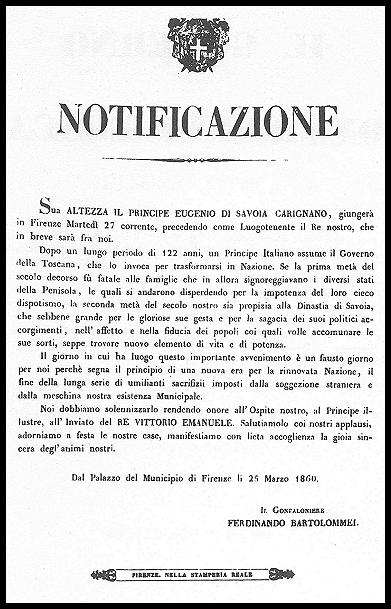
Fig. 1: the notification to inform about the Eugenio from Savoy arrival.
(taken from "1848-1862 - La posta militare Toscana" of A. Palmieri)
The Tuscany Grand Duchy
If we would like,
even only briefly, to write about the Tuscany Grand Duchy history we would need
to fulfill several books...
The Grand Duchy has its birth as such in 1570, under the leading of Cosimo de'
Medici, Duke of Florence. The Medici descent halted in 1773 and the territory
went under the Augsburg-Lorena family, precisely under Francesco Stefano from
Lorena, husband of the daughter of the Austria Emperor. In 1799 the grand Duchy
was occupied by the French who stayed for not so long, defeated by the Austrian.
The French did occupy the territory again in 1801 and the Borboni dynasty came
to the throne starting with the son of the Parma duke. From 1807 it was invaded
by the French, by the Spaniards, by Parma and by Naples army. After alternate
events in 1814 the Lorena came back to the throne with Ferdinand III. They reigned
with continuity until the "Risorgimento" raisings.
In 1851, at the time of the first stamp issue, Leopold II was the King, supported,
of course, by the Austrian. The territory surface was around 21,700 Km square,
with 1,8 millions of habitants. The territory comprehended the Elba Island and
some other smaller islands. The provinces were Arezzo, Florence, Grosseto, Livorno,
Lucca, Pisa and Siena.
That
things were going to the worse it was already understood in 1848 when ideas
always more revolutionary and liberal started to circulate, even if with less
diffusion than in the other Duchies. These always growing pushes to become independent
reached their peak in 1849 when Leopold II was obliged to take shelter in Gaeta.
The Austrian reestablished the previous status allowing for the comeback of
the Duke and maintaining their presence in the Grand Duchy. We arrive in this
way to the 1859, to the 2nd Independence War and to the secret agreements between
Cavour and Napoleon III. Cavour, great and skilled strategist, leveraging the
alliance with the French, was able to get the War Declaration from the Austrian.
I have already mentioned in the historic introduction of the other States what
happened in the various territories. In Tuscany, Cavour skillfully had supported
and fed raisings and insurrections aimed to create dissatisfaction in the people,
more in theory than true, starting from the Leopold II refusal to support the
Sardinian State in the war against the Austrian; Cavour was able to fulfill
his goal: on April 27th 1859 Leopold II leave Florence, supported indeed by
the people, that was not so keen to join the Piedmont....
Royal Commissioner was nominated Carlo Boncompagni, Sardinia ambassador in Florence.
The Provisional Government is formed. Boncompagni is called back in Turin, the
dictatorship is taken on in August 1st 1859 by Benito Ricasoli, Minister of
Foreign Affairs. In 1860 (March 11 and 12) the plebiscites take place, plebiscite
that do have very small of popular event, perhaps nothing... but this is history!
In March 22nd the Tuscany annexation is a done deal. Until February 13th 1861
Eugenio from Savoy was the lieutenant. March 17th 1861 the Italy Kingdom was
proclaimed.

Fig. 1: the notification
to inform about the Eugenio from Savoy arrival.
(taken from "1848-1862 - La posta militare Toscana" of A. Palmieri)
The range of the Tuscany currencies at that time is really complex: they were
Soldi, Crazie, Quattrini, Francesconi, Paoli and who has more can add to them.
I will limit my discussion to the ones strictly related to the philately.
The official currency was the Tuscany Lira that was made by 12 Crazie, equivalent
to 20 Soldi, equivalent to 60 Quattrini.
Therefore to say 1 Lira, or 12 Crazie or 20 Soldi or 60 Quattrini is exactly
the same thing...
One Tuscany Lira was equivalent to 84 centesimi of an Italian Lira.
From November 1859, after the creation of the Provisional Government, the new
currency became the Italian Lira, of 100 centesimi.
The Postal
Service in Tuscany has been always very efficient, with mail carriers and couriers
well organized, supported later on even with various railroad pieces and developed
transportations by sea. Here are, following the postal agreements with Austria
of November 5th 1850, the main rates valid for an internal letter, clarifying
1 Denaro is equal to 1.15 grams and ed one once 28.28. At the beginning (until
October 1852) the letters without stamps paid at the arrival, beyond the shipment
fee, another tax of 2 Crazie.
|
Simple letter up to the weight of 6 denari |
2 Crazie
|
| Simple letter up to the weight of 12 denari |
3 Crazie
|
| Simple letter up to the weight of 18 denari |
5 Crazie
|
| Simple letter up to the weight of 24 denari |
8 Cazie
|
| Simple letter up to the weight of 1 ounce |
10 Crazie
|
| Newspaper (up to 6/30/1857, each sheet) |
1 Quattrino
|
| Prints (any type, from 7/01/1857, each ounce, which is 28.3 gr.) |
2 Quattrini
|
| Recommendation |
+8 Crazie
|
From January 1st 1860 the provisional
Government stamps were used.
The letters without stamps paid at the arrival twice the fee of the tax not
applied.
The following were the new rates (letters each 10 grams of weight):
| Letter inside the district |
5 centesimi
|
| Letter, other destinations |
10 centesimi
|
| Newspaper each 20 grams |
1 centesimo
|
| Prints each 40 grams |
2 centesimi
|
| Recommendation |
+25 centesimi
|